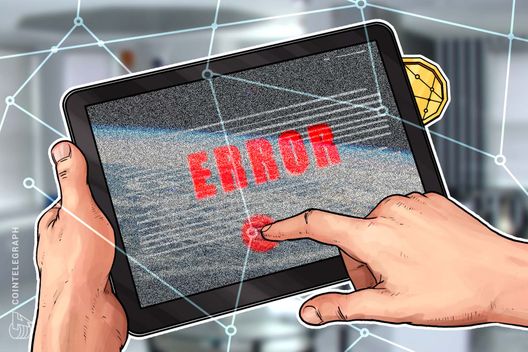What is the wash-sale rule, and does it apply to crypto?
What is Bitcoin? How does blockchain work? How to mine cryptocurrency? We are glad to help you answer these questions with our quick guides in Explained section.
rn”,”seo_description”:”What is Bitcoin? How does blockchain work? How to mine cryptocurrency? We are glad to help you answer these questions with our quick guides in Explained section.”},”words_count”:824,”description”:” The wash-sale rule disallows the deduction of losses if identical securities or crypto assets are repurchased within 30 days.rn “,”author”:{“id”:1470,”title”:”Onkar Singh”,”url”:”onkar-singh”,”twitter”:””,”google_plus”:””,”photo”:””,”gender”:”male”,”description”:”Onkar Singh is a blockchain enthusiast as he keeps a tab on the recent happenings pertaining to the crypto industry. He aims to provide quality content in blockchain and crypto domain. He is a financial content writer too and has worked on several financial projects related to the stock market news, fundamental research, and technical analysis for several websites.”,”facebook”:””,”email”:””,”linkedin”:””,”created_at”:”2022-01-28 14:30:55″,”updated_at”:”2022-04-05 22:44:33″,”deleted_at”:null,”innovation_circle_url”:null,”avatar”:”https://cointelegraph.com/assets/img/icons/author_male.jpg”,”hash”:”aHR0cHM6Ly9jb2ludGVsZWdyYXBoLmNvbS9hdXRob3JzL29ua2FyLXNpbmdo”,”relativeUrl”:”https://cointelegraph.com/authors/onkar-singh”,”user_id”:1470,”language_id”:1,”name”:”Onkar Singh”,”desc”:”Onkar Singh is a blockchain enthusiast as he keeps a tab on the recent happenings pertaining to the crypto industry. He aims to provide quality content in blockchain and crypto domain. He is a financial content writer too and has worked on several financial projects related to the stock market news, fundamental research, and technical analysis for several websites.”,”seo_title”:””,”seo_description”:””,”enabled”:1,”show_in_authors”:0,”show_in_experts”:0},”category_id”:65,”audio”:”https://s3.cointelegraph.com/audio/107606.b4d65637-6931-4816-be6e-248f98ee779a.mp3″,”tags”:[{“name”:”Bitcoin”,”uri”:”/tags/bitcoin”,”super”:1,”page_title”:”Bitcoin News”},{“name”:”Cryptocurrencies”,”uri”:”/tags/cryptocurrencies”,”super”:0,”page_title”:”Cryptocurrencies News”},{“name”:”Investments”,”uri”:”/tags/investments”,”super”:0,”page_title”:”Investments News”},{“name”:”Trading”,”uri”:”/tags/trading”,”super”:0,”page_title”:”Trading News”}],”tag_title”:”Bitcoin”,”date”:”28 MINUTES AGO”,”badge”:{“title”:”Explained”,”label”:”default”},”qty”:5,”stats_pixel”:”“,”stats_pixel_url”:”https://zoa.cointelegraph.com/pixel?postId=107606®ionId=1″,”shares”:1,”infographic”:false,”sponsored”:false,”explained”:true,”press_release”:false,”show_referral”:false,”social_description”:” Did you know the wash-sale rule applies to crypto, too? Understand the implications for your crypto tax planning and avoid costly mistakes. “,”social_translators”:{“clipboard_popup_label”:”Link copied”,”socialWechatFooterError”:”WeChat error”,”socialWechatFooterText”:”WeChat share”,”socialWechatHeaderText”:”WeChat share”},”social_shares”:{“post_id”:107606,”post_url”:”https://cointelegraph.com/explained/what-is-the-wash-sale-rule-and-does-it-apply-to-crypto”,”post_titles”:{“normal”:”What is the wash-sale rule, and does it apply to crypto?”,”twitter”:”What is the wash-sale rule, and does it apply to crypto?”},”post_text”:{“normal”:”What is the wash-sale rule, and does it apply to crypto?”,”twitter”:”What is the wash-sale rule, and does it apply to crypto? https://cointelegraph.com/explained/what-is-the-wash-sale-rule-and-does-it-apply-to-crypto via @cointelegraph”},”accounts”:{“twitter”:”@cointelegraph”}},”socials”:{“facebook”:{“url”:”https://www.facebook.com/sharer/sharer.php?u=https%3A%2F%2Fcointelegraph.com%2Fexplained%2Fwhat-is-the-wash-sale-rule-and-does-it-apply-to-crypto”,”count”:null,”short”:”fb”,”fa”:”facebook”},”twitter”:{“url”:”https://twitter.com/intent/tweet?text=What+is+the+wash-sale+rule%2C+and+does+it+apply+to+crypto%3F https%3A%2F%2Fcointelegraph.com%2Fexplained%2Fwhat-is-the-wash-sale-rule-and-does-it-apply-to-crypto via @cointelegraph”,”count”:null,”short”:”tw”,”fa”:”twitter”},”telegram”:{“url”:”https://telegram.me/share/url?url=https%3A%2F%2Fcointelegraph.com%2Fexplained%2Fwhat-is-the-wash-sale-rule-and-does-it-apply-to-crypto &text=What+is+the+wash-sale+rule%2C+and+does+it+apply+to+crypto%3F”,”count”:null,”short”:”tg”,”fa”:”paper-plane”},”whatsapp”:{“url”:”https://api.whatsapp.com/send?text=What+is+the+wash-sale+rule%2C+and+does+it+apply+to+crypto%3F&href=https%3A%2F%2Fcointelegraph.com%2Fexplained%2Fwhat-is-the-wash-sale-rule-and-does-it-apply-to-crypto”,”count”:null,”short”:”wu”,”fa”:”whatsapp”},”gplus”:{“url”:”https://plus.google.com/share?url=https%3A%2F%2Fcointelegraph.com%2Fexplained%2Fwhat-is-the-wash-sale-rule-and-does-it-apply-to-crypto”,”count”:null,”short”:”gplus”,”fa”:”google-plus”},”reddit”:{“url”:”https://www.reddit.com/submit?url=https%3A%2F%2Fcointelegraph.com%2Fexplained%2Fwhat-is-the-wash-sale-rule-and-does-it-apply-to-crypto&title=What+is+the+wash-sale+rule%2C+and+does+it+apply+to+crypto%3F”,”count”:null,”short”:”reddit”,”fa”:”reddit-alien”},”linkedin”:{“url”:”https://www.linkedin.com/shareArticle?mini=true&url=https%3A%2F%2Fcointelegraph.com%2Fexplained%2Fwhat-is-the-wash-sale-rule-and-does-it-apply-to-crypto&title=What+is+the+wash-sale+rule%2C+and+does+it+apply+to+crypto%3F”,”count”:null,”short”:”li”,”fa”:”linkedin”}},”hide_disclaimer”:false,”elink”:”https://cointelegraph.com”,”etitle”:”Cointelegraph”,”elogo_x2″:”https://images.cointelegraph.com/images/528_V2hhdCBpcyB0aGUgd2FzaC1zYWxlIHJ1bGU/.jpg”,”elogo_x1″:”https://images.cointelegraph.com/images/260_V2hhdCBpcyB0aGUgd2FzaC1zYWxlIHJ1bGU/.jpg”,”elogo_svg”:false,”content”:[{“id”:4128,”post_id”:107606,”title”:”What is the wash-sale rule?”,”content”:”
Investors cannot claim a tax loss on the sale of a security if they buy a “substantially identical” security within 30 days before or after the sale, as per the wash-sale rule, a tax regulation.
nn
The Internal Revenue Service (IRS) in the United States established the wash-sale rule, which restricts investors from deducting a tax loss from their taxes if they sell an investment at a loss and subsequently buy a virtually identical security within the 30-day window. Instead, they must factor the loss into the new security’s cost base, which will reduce their gain or raise their loss when they ultimately sell the new asset.
nn
Cost basis refers to the original value of an asset, such as a stock or a cryptocurrency, that is used to determine the taxable gain or loss when the asset is sold or disposed of. The cost basis is typically the purchase price of the asset, including any fees or commissions associated with the purchase. The cost basis may be changed to reflect the asset’s fair market value at the time of acquisition if the asset was received as a gift or through inheritance.
nn
When an asset is sold, the capital gain or loss is determined using the cost basis. The investor obtains a capital gain and may be subject to taxation on that gain if the asset’s sale price exceeds its cost basis. The investor experiences a capital loss if the sale price is less than the cost basis. This loss can be used to offset capital gains and minimize the investor’s tax burden.
nn
“Substantially identical” refers to securities that are almost identical to the security sold, as in the case of purchasing a stock, selling it, and purchasing the original stock back within 30 days. However, it can be difficult to determine what constitutes a substantially identical security, and the IRS has broad discretion in making this determination.
nn
The wash-sale rule was created to stop investors from claiming tax deductions for losses while maintaining their portfolio’s original structure. All forms of securities, such as stocks, bonds, mutual funds and options, are covered by this rule.
nn
For instance, the wash-sale rule would likely apply, and the investor would not be able to claim the tax loss on the sale if the investor sold shares of a certain company at a loss and then purchased shares of the same company or a company that is similar in the same industrial sector within 30 days. In a similar vein, if an investor sells shares in a mutual fund that tracks the S&P 500 index and then purchases shares of a different mutual fund that tracks the same index within 30 days, the investor is subject to a 30-day penalty.
nn
Related: How are metaverse assets taxed?
nnnnnnn”,”created_at”:”2023-05-01 09:29:07″,”updated_at”:”2023-05-01 09:34:52″,”sort”:1,”translations”:{“id”:4121,”explained_post_id”:4128,”title_en”:”What is the wash-sale rule?”,”content_en”:”
Investors cannot claim a tax loss on the sale of a security if they buy a “substantially identical” security within 30 days before or after the sale, as per the wash-sale rule, a tax regulation.
nn
The Internal Revenue Service (IRS) in the United States established the wash-sale rule, which restricts investors from deducting a tax loss from their taxes if they sell an investment at a loss and subsequently buy a virtually identical security within the 30-day window. Instead, they must factor the loss into the new security’s cost base, which will reduce their gain or raise their loss when they ultimately sell the new asset.
nn
Cost basis refers to the original value of an asset, such as a stock or a cryptocurrency, that is used to determine the taxable gain or loss when the asset is sold or disposed of. The cost basis is typically the purchase price of the asset, including any fees or commissions associated with the purchase. The cost basis may be changed to reflect the asset’s fair market value at the time of acquisition if the asset was received as a gift or through inheritance.
nn
When an asset is sold, the capital gain or loss is determined using the cost basis. The investor obtains a capital gain and may be subject to taxation on that gain if the asset’s sale price exceeds its cost basis. The investor experiences a capital loss if the sale price is less than the cost basis. This loss can be used to offset capital gains and minimize the investor’s tax burden.
nn
“Substantially identical” refers to securities that are almost identical to the security sold, as in the case of purchasing a stock, selling it, and purchasing the original stock back within 30 days. However, it can be difficult to determine what constitutes a substantially identical security, and the IRS has broad discretion in making this determination.
nn
The wash-sale rule was created to stop investors from claiming tax deductions for losses while maintaining their portfolio’s original structure. All forms of securities, such as stocks, bonds, mutual funds and options, are covered by this rule.
nn
For instance, the wash-sale rule would likely apply, and the investor would not be able to claim the tax loss on the sale if the investor sold shares of a certain company at a loss and then purchased shares of the same company or a company that is similar in the same industrial sector within 30 days. In a similar vein, if an investor sells shares in a mutual fund that tracks the S&P 500 index and then purchases shares of a different mutual fund that tracks the same index within 30 days, the investor is subject to a 30-day penalty.
nn
Related: How are metaverse assets taxed?
nnnnnnn”,”title_es”:””,”content_es”:”nnnnn”,”title_cn”:””,”content_cn”:”nnnnn”,”title_de”:””,”content_de”:”nnnnn”,”title_fr”:””,”content_fr”:”nnnnn”,”title_it”:””,”content_it”:”nnnnn”,”title_ar”:””,”content_ar”:”nnnnn”,”title_br”:””,”content_br”:”nnnnn”,”title_jp”:””,”content_jp”:”nnnnn”,”created_at”:”2023-05-01 09:29:07″,”updated_at”:”2023-05-01 09:34:52″,”title_kr”:””,”content_kr”:”nnnnn”,”title_tr”:””,”content_tr”:”nnnnn”}},{“id”:4129,”post_id”:107606,”title”:”Does the wash-sale rule apply to crypto?”,”content”:”
Yes, the wash-sale penalty rule applies to crypto and other assets subject to capital gains taxes. However, there is no proper legislation in effect for crypto assets.
nn
Since the IRS has not offered clear guidance on this subject, it is unclear how the wash-sale regulation applies to cryptocurrencies. The wash-sale rule is usually believed to apply to cryptocurrencies in the same manner as it does to other kinds of assets, though.
nn
The U.S. government tried to implement a crypto wash-sale rule through the Build Better Act in 2021, which passed in the House of Representatives but was ultimately defeated in the Senate. That said, if an investor sells a cryptocurrency at a loss and buys it in a 30-day window, the IRS considers the new purchase to be a “wash sale,” which means that the loss is disallowed and added to the cost basis of the new security.
nn
Cryptocurrency investors may employ tax-loss harvesting opportunities and tax planning strategies to reduce their tax liability, but they must be cautious to avoid breaking the wash-sale rule.
nn
To ensure compliance with the rule and other crypto tax requirements, it is crucial to maintain precise records of all cryptocurrency transactions. Investors in cryptocurrencies can benefit from consulting with a tax expert to better understand the complicated world of crypto taxes and make sure they are maximizing tax benefits while reducing tax obligations.
nnnnnn”,”created_at”:”2023-05-01 09:30:03″,”updated_at”:”2023-05-01 09:34:52″,”sort”:2,”translations”:{“id”:4122,”explained_post_id”:4129,”title_en”:”Does the wash-sale rule apply to crypto?”,”content_en”:”
Yes, the wash-sale penalty rule applies to crypto and other assets subject to capital gains taxes. However, there is no proper legislation in effect for crypto assets.
nn
Since the IRS has not offered clear guidance on this subject, it is unclear how the wash-sale regulation applies to cryptocurrencies. The wash-sale rule is usually believed to apply to cryptocurrencies in the same manner as it does to other kinds of assets, though.
nn
The U.S. government tried to implement a crypto wash-sale rule through the Build Better Act in 2021, which passed in the House of Representatives but was ultimately defeated in the Senate. That said, if an investor sells a cryptocurrency at a loss and buys it in a 30-day window, the IRS considers the new purchase to be a “wash sale,” which means that the loss is disallowed and added to the cost basis of the new security.
nn
Cryptocurrency investors may employ tax-loss harvesting opportunities and tax planning strategies to reduce their tax liability, but they must be cautious to avoid breaking the wash-sale rule.
nn
To ensure compliance with the rule and other crypto tax requirements, it is crucial to maintain precise records of all cryptocurrency transactions. Investors in cryptocurrencies can benefit from consulting with a tax expert to better understand the complicated world of crypto taxes and make sure they are maximizing tax benefits while reducing tax obligations.
nnnnnn”,”title_es”:””,”content_es”:”nnnn”,”title_cn”:””,”content_cn”:”nnnn”,”title_de”:””,”content_de”:”nnnn”,”title_fr”:””,”content_fr”:”nnnn”,”title_it”:””,”content_it”:”nnnn”,”title_ar”:””,”content_ar”:”nnnn”,”title_br”:””,”content_br”:”nnnn”,”title_jp”:””,”content_jp”:”nnnn”,”created_at”:”2023-05-01 09:30:03″,”updated_at”:”2023-05-01 09:34:52″,”title_kr”:””,”content_kr”:”nnnn”,”title_tr”:””,”content_tr”:”nnnn”}},{“id”:4130,”post_id”:107606,”title”:”How does the wash-sale rule work?”,”content”:”
The wash-sale rule disallows the use of capital losses for tax purposes if an investor buys back a substantially identical security or crypto asset within 30 days of selling it.
nn
Understanding the wash-sale rule and other tax regulations is crucial for crypto investors to minimize their tax liabilities and stay compliant with IRS rules. Here’s a step-by-step explanation of how the wash-sale rule works:
nn
- nt
- An investor sells a security, such as a stock or a cryptocurrency, at a loss.
- Within 30 days before or after the sale, the investor buys the same or a substantially identical security.
- The wash-sale rule applies, and the loss is disallowed for tax purposes.
- The cost basis of the new security is adjusted to reflect the disallowed loss.
- If the investor later sells the new security for a gain, the adjusted cost basis is used to calculate the taxable gain.
nt
nt
nt
nt
n
nn
Consider a scenario where an investor purchases 1 Bitcoin (BTC) for $50,000 and then sells it for $40,000, suffering a loss of $10,000. The wash-sale rule will be applied if the investor purchases another BTC within 30 days of the transaction for $55,000; in this case, the $10,000 loss is disallowed, and the new Bitcoin’s cost basis is changed to $50,000 to reflect this loss.
nn
If the investor later sold the new BTC for $70,000, the taxable gain would be $20,000 ($70,000–$50,000) as opposed to $15,000, as it would have been if the cost basis had not been changed.
nn
The wash-sale regulation barred the investor from using the $10,000 loss they sustained on the initial Bitcoin purchase, despite the fact that they had incurred a loss. The disallowed loss was instead applied to the new Bitcoin’s cost basis, raising the taxable gain from the sale of the new Bitcoin.
nn
Related: What can you buy with Bitcoin?: A beginner’s guide to spending your BTC
nnnnnn”,”created_at”:”2023-05-01 09:30:35″,”updated_at”:”2023-05-01 09:34:52″,”sort”:3,”translations”:{“id”:4123,”explained_post_id”:4130,”title_en”:”How does the wash-sale rule work?”,”content_en”:”
The wash-sale rule disallows the use of capital losses for tax purposes if an investor buys back a substantially identical security or crypto asset within 30 days of selling it.
nn
Understanding the wash-sale rule and other tax regulations is crucial for crypto investors to minimize their tax liabilities and stay compliant with IRS rules. Here’s a step-by-step explanation of how the wash-sale rule works:
nn
- nt
- An investor sells a security, such as a stock or a cryptocurrency, at a loss.
- Within 30 days before or after the sale, the investor buys the same or a substantially identical security.
- The wash-sale rule applies, and the loss is disallowed for tax purposes.
- The cost basis of the new security is adjusted to reflect the disallowed loss.
- If the investor later sells the new security for a gain, the adjusted cost basis is used to calculate the taxable gain.
nt
nt
nt
nt
n
nn
Consider a scenario where an investor purchases 1 Bitcoin (BTC) for $50,000 and then sells it for $40,000, suffering a loss of $10,000. The wash-sale rule will be applied if the investor purchases another BTC within 30 days of the transaction for $55,000; in this case, the $10,000 loss is disallowed, and the new Bitcoin’s cost basis is changed to $50,000 to reflect this loss.
nn
If the investor later sold the new BTC for $70,000, the taxable gain would be $20,000 ($70,000–$50,000) as opposed to $15,000, as it would have been if the cost basis had not been changed.
nn
The wash-sale regulation barred the investor from using the $10,000 loss they sustained on the initial Bitcoin purchase, despite the fact that they had incurred a loss. The disallowed loss was instead applied to the new Bitcoin’s cost basis, raising the taxable gain from the sale of the new Bitcoin.
nn
Related: What can you buy with Bitcoin?: A beginner’s guide to spending your BTC
nnnnnn”,”title_es”:””,”content_es”:”nnnn”,”title_cn”:””,”content_cn”:”nnnn”,”title_de”:””,”content_de”:”nnnn”,”title_fr”:””,”content_fr”:”nnnn”,”title_it”:””,”content_it”:”nnnn”,”title_ar”:””,”content_ar”:”nnnn”,”title_br”:””,”content_br”:”nnnn”,”title_jp”:””,”content_jp”:”nnnn”,”created_at”:”2023-05-01 09:30:35″,”updated_at”:”2023-05-01 09:34:52″,”title_kr”:””,”content_kr”:”nnnn”,”title_tr”:””,”content_tr”:”nnnn”}},{“id”:4131,”post_id”:107606,”title”:”How to avoid wash-sale rule violations?”,”content”:”
To avoid wash-sale rule violations, investors should consider the wash-sale rule, invest in crypto mutual funds after incurring a loss from the sale of a crypto asset, or buy another asset with a very high correlation to it.
nn
In general, investors can reduce the risk of wash-sale rule violations by waiting at least 31 days before buying back a substantially identical security or crypto asset, or by selling a security or crypto asset at a loss and immediately buying a similar but not substantially identical security or crypto asset.
nn

nn
After suffering a loss from the sale of a crypto asset, buying a cryptocurrency mutual fund could be a means to avoid breaking wash-sale rules. The investor can still take part in the cryptocurrency market and possibly profit from prospects for tax-loss harvesting by investing in a mutual fund without breaking the wash-sale regulation.
nn
Nonetheless, it’s crucial to remember that each mutual fund has its own distinct risks, so investors should do their research before investing in any mutual fund. In order to fully comprehend the tax ramifications of investing in a mutual fund and to ensure compliance with tax rules and regulations, investors should be aware of the taxes applicable in their jurisdiction.
nn
Selling the asset that has suffered a loss and purchasing another asset that has a very high correlation to it could help one avoid violating wash-sale rules. In this way, the investor can still profit from market changes without being subject to the wash-sale rule. However, the new asset shouldn’t be nearly identical to the original asset because doing so could still result in a violation of the wash-sale regulation.
nn
Also, before making any investment decisions, the investor should be aware of the risks and any tax repercussions connected to this strategy. Investors should always check their investments to guarantee compliance with tax rules and regulations because the correlation between two assets is a dynamic concept that is subject to change over time.
nnnnn”,”created_at”:”2023-05-01 09:32:18″,”updated_at”:”2023-05-01 09:34:51″,”sort”:4,”translations”:{“id”:4124,”explained_post_id”:4131,”title_en”:”How to avoid wash-sale rule violations?”,”content_en”:”
To avoid wash-sale rule violations, investors should consider the wash-sale rule, invest in crypto mutual funds after incurring a loss from the sale of a crypto asset, or buy another asset with a very high correlation to it.
nn
In general, investors can reduce the risk of wash-sale rule violations by waiting at least 31 days before buying back a substantially identical security or crypto asset, or by selling a security or crypto asset at a loss and immediately buying a similar but not substantially identical security or crypto asset.
nn

nn
After suffering a loss from the sale of a crypto asset, buying a cryptocurrency mutual fund could be a means to avoid breaking wash-sale rules. The investor can still take part in the cryptocurrency market and possibly profit from prospects for tax-loss harvesting by investing in a mutual fund without breaking the wash-sale regulation.
nn
Nonetheless, it’s crucial to remember that each mutual fund has its own distinct risks, so investors should do their research before investing in any mutual fund. In order to fully comprehend the tax ramifications of investing in a mutual fund and to ensure compliance with tax rules and regulations, investors should be aware of the taxes applicable in their jurisdiction.
nn
Selling the asset that has suffered a loss and purchasing another asset that has a very high correlation to it could help one avoid violating wash-sale rules. In this way, the investor can still profit from market changes without being subject to the wash-sale rule. However, the new asset shouldn’t be nearly identical to the original asset because doing so could still result in a violation of the wash-sale regulation.
nn
Also, before making any investment decisions, the investor should be aware of the risks and any tax repercussions connected to this strategy. Investors should always check their investments to guarantee compliance with tax rules and regulations because the correlation between two assets is a dynamic concept that is subject to change over time.
nnnnn”,”title_es”:””,”content_es”:”nnn”,”title_cn”:””,”content_cn”:”nnn”,”title_de”:””,”content_de”:”nnn”,”title_fr”:””,”content_fr”:”nnn”,”title_it”:””,”content_it”:”nnn”,”title_ar”:””,”content_ar”:”nnn”,”title_br”:””,”content_br”:”nnn”,”title_jp”:””,”content_jp”:”nnn”,”created_at”:”2023-05-01 09:32:18″,”updated_at”:”2023-05-01 09:34:51″,”title_kr”:””,”content_kr”:”nnn”,”title_tr”:””,”content_tr”:”nnn”}}],”is_partner_material”:false,”commentsSection”:{“schemaEntityUrl”:”//cointelegraph.com/explained/what-is-the-wash-sale-rule-and-does-it-apply-to-crypto”,”list”:[],”amount”:0,”i18n”:{“addComment”:”Add a comment…”,”amountOnePostfix”:”Comment”,”amountPostfix”:”Comments”,”cancel”:”Cancel”,”delete”:”Delete”,”edit”:”Edit”,”errorBig”:”Comment text cannot be longer than 2000 characters”,”errorDuplicate”:”Duplicate comment”,”errorSmall”:”Comment text must be at least 2 characters long”,”hideButton”:”Hide comments”,”noComments”:” “,”commentOnModeration”:”Comment on moderation”,”postComment”:”Post”,”reply”:”Reply”,”showAllComments”:”Show All Comments”,”showButtonPostfix”:”comments”,”showButtonPrefix”:”Show”,”signIn”:”Sign in”,”update”:”Update comment”,”commentWasDeleted”:”This comment has been deleted”}},”related”:[{“id”:105835,”retina”:”https://images.cointelegraph.com/cdn-cgi/image/format=auto,onerror=redirect,quality=90,width=1480/https://s3.cointelegraph.com/storage/uploads/view/d41867f0cf4f219a5bab4ebc7976a48d.jpeg”,”img”:”https://images.cointelegraph.com/cdn-cgi/image/format=auto,onerror=redirect,quality=90,width=740/https://s3.cointelegraph.com/storage/uploads/view/d41867f0cf4f219a5bab4ebc7976a48d.jpeg”,”thumb”:”https://images.cointelegraph.com/cdn-cgi/image/format=auto,onerror=redirect,quality=90,width=370/https://s3.cointelegraph.com/storage/uploads/view/d41867f0cf4f219a5bab4ebc7976a48d.jpeg”,”thumb370″:”https://images.cointelegraph.com/cdn-cgi/image/format=auto,onerror=redirect,quality=90,width=370/https://s3.cointelegraph.com/storage/uploads/view/d41867f0cf4f219a5bab4ebc7976a48d.jpeg”,”amp_thumb”:”https://images.cointelegraph.com/cdn-cgi/image/format=auto,onerror=redirect,quality=90,width=150/https://s3.cointelegraph.com/storage/uploads/view/d41867f0cf4f219a5bab4ebc7976a48d.jpeg”,”thumb150″:”https://images.cointelegraph.com/cdn-cgi/image/format=auto,onerror=redirect,quality=90,width=150/https://s3.cointelegraph.com/storage/uploads/view/d41867f0cf4f219a5bab4ebc7976a48d.jpeg”,”url”:”https://cointelegraph.com/explained/what-are-dynamic-nfts-use-cases-and-examples”,”title”:”What are dynamic NFTs?: Use cases and examples “,”lead”:”Explore use cases and examples of dynamic NFTs, unique digital assets that can be programmed to change over time.”,”leadfull”:””,”category_id”:65,”category_url”:”https://cointelegraph.com/explained”,”category_title”:”Explained”,”author_url”:”https://cointelegraph.com/authors/sasha-shilina”,”author_hash”:”aHR0cHM6Ly9jb2ludGVsZWdyYXBoLmNvbS9hdXRob3JzL3Nhc2hhLXNoaWxpbmE=”,”author_title”:”Sasha Shilina”,”author_img”:”https://images.cointelegraph.com/cdn-cgi/image/format=auto,onerror=redirect,quality=90,width=32/https://s3.cointelegraph.com/storage/uploads/view/5d1d60470a33cd5268c8885651d3f5cc.jpg”,”date”:”APR 03, 2023″,”flash_date”:”APR 03, 2023″,”sponsored”:false,”press_release”:false,”sponsored_label”:”Sponsored”,”explained”:true,”badge”:{“title”:”Explained”,”label”:”default”},”published”:{“date”:”2023-04-03 13:15:00.000000″,”timezone_type”:3,”timezone”:”Europe/London”},”stat_uniqs”:502,”rss_date”:”Mon, 03 Apr 2023 13:15:00 +0100″,”publishedW3″:”2023-04-03T13:15:00+01:00″,”show_referral”:false,”isMagazine”:false},{“id”:106067,”retina”:”https://images.cointelegraph.com/cdn-cgi/image/format=auto,onerror=redirect,quality=90,width=1480/https://s3.cointelegraph.com/storage/uploads/view/884636d2ebfed47b727325d8e36c1a93.jpg”,”img”:”https://images.cointelegraph.com/cdn-cgi/image/format=auto,onerror=redirect,quality=90,width=740/https://s3.cointelegraph.com/storage/uploads/view/884636d2ebfed47b727325d8e36c1a93.jpg”,”thumb”:”https://images.cointelegraph.com/cdn-cgi/image/format=auto,onerror=redirect,quality=90,width=370/https://s3.cointelegraph.com/storage/uploads/view/884636d2ebfed47b727325d8e36c1a93.jpg”,”thumb370″:”https://images.cointelegraph.com/cdn-cgi/image/format=auto,onerror=redirect,quality=90,width=370/https://s3.cointelegraph.com/storage/uploads/view/884636d2ebfed47b727325d8e36c1a93.jpg”,”amp_thumb”:”https://images.cointelegraph.com/cdn-cgi/image/format=auto,onerror=redirect,quality=90,width=150/https://s3.cointelegraph.com/storage/uploads/view/884636d2ebfed47b727325d8e36c1a93.jpg”,”thumb150″:”https://images.cointelegraph.com/cdn-cgi/image/format=auto,onerror=redirect,quality=90,width=150/https://s3.cointelegraph.com/storage/uploads/view/884636d2ebfed47b727325d8e36c1a93.jpg”,”url”:”https://cointelegraph.com/explained/crypto-trading-vs-crypto-investing-key-differences-explained”,”title”:”Crypto trading vs. crypto investing: Key differences explained”,”lead”:”Crypto trading and investing are often intertwined, but key differences remain between the two methods.”,”leadfull”:””,”category_id”:65,”category_url”:”https://cointelegraph.com/explained”,”category_title”:”Explained”,”author_url”:”https://cointelegraph.com/authors/marcel-deer”,”author_hash”:”aHR0cHM6Ly9jb2ludGVsZWdyYXBoLmNvbS9hdXRob3JzL21hcmNlbC1kZWVy”,”author_title”:”Marcel Deer”,”author_img”:”https://images.cointelegraph.com/cdn-cgi/image/format=auto,onerror=redirect,quality=90,width=32/https://s3.cointelegraph.com/storage/uploads/view/a427b150b57d0a9ad4054cf042cf01b8.jpg”,”date”:”APR 06, 2023″,”flash_date”:”APR 06, 2023″,”sponsored”:false,”press_release”:false,”sponsored_label”:”Sponsored”,”explained”:true,”badge”:{“title”:”Explained”,”label”:”default”},”published”:{“date”:”2023-04-06 09:46:00.000000″,”timezone_type”:3,”timezone”:”Europe/London”},”stat_uniqs”:90,”rss_date”:”Thu, 06 Apr 2023 09:46:00 +0100″,”publishedW3″:”2023-04-06T09:46:00+01:00″,”show_referral”:false,”isMagazine”:false},{“id”:106068,”retina”:”https://images.cointelegraph.com/cdn-cgi/image/format=auto,onerror=redirect,quality=90,width=1480/https://s3.cointelegraph.com/uploads/2023-04/1c538386-8fae-434e-9956-1cee9706e49e.jpg”,”img”:”https://images.cointelegraph.com/cdn-cgi/image/format=auto,onerror=redirect,quality=90,width=740/https://s3.cointelegraph.com/uploads/2023-04/1c538386-8fae-434e-9956-1cee9706e49e.jpg”,”thumb”:”https://images.cointelegraph.com/cdn-cgi/image/format=auto,onerror=redirect,quality=90,width=370/https://s3.cointelegraph.com/uploads/2023-04/1c538386-8fae-434e-9956-1cee9706e49e.jpg”,”thumb370″:”https://images.cointelegraph.com/cdn-cgi/image/format=auto,onerror=redirect,quality=90,width=370/https://s3.cointelegraph.com/uploads/2023-04/1c538386-8fae-434e-9956-1cee9706e49e.jpg”,”amp_thumb”:”https://images.cointelegraph.com/cdn-cgi/image/format=auto,onerror=redirect,quality=90,width=150/https://s3.cointelegraph.com/uploads/2023-04/1c538386-8fae-434e-9956-1cee9706e49e.jpg”,”thumb150″:”https://images.cointelegraph.com/cdn-cgi/image/format=auto,onerror=redirect,quality=90,width=150/https://s3.cointelegraph.com/uploads/2023-04/1c538386-8fae-434e-9956-1cee9706e49e.jpg”,”url”:”https://cointelegraph.com/news/nigerian-crypto-foreign-investment-is-at-a-record-low-study”,”title”:”Nigerian crypto foreign investment is at a record low: Study”,”lead”:”Foreign direct investment in Nigeria fell by 33% last year due to a severe shortage of dollars, which discouraged crypto companies from expanding into the count…”,”leadfull”:””,”category_id”:2,”category_url”:”https://cointelegraph.com/category/latest-news”,”category_title”:”Latest News”,”author_url”:”https://cointelegraph.com/authors/amaka-nwaokocha”,”author_hash”:”aHR0cHM6Ly9jb2ludGVsZWdyYXBoLmNvbS9hdXRob3JzL2FtYWthLW53YW9rb2NoYQ==”,”author_title”:” Amaka Nwaokocha “,”author_img”:”https://images.cointelegraph.com/cdn-cgi/image/format=auto,onerror=redirect,quality=90,width=32/https://s3.cointelegraph.com/storage/uploads/view/501901c1e41af6d7cb2962f6c89d7e04.jpg”,”date”:”APR 06, 2023″,”flash_date”:”APR 06, 2023″,”sponsored”:false,”press_release”:false,”sponsored_label”:”Sponsored”,”explained”:false,”badge”:{“title”:”News”,”label”:”default”},”published”:{“date”:”2023-04-06 10:20:00.000000″,”timezone_type”:3,”timezone”:”Europe/London”},”stat_uniqs”:2071,”rss_date”:”Thu, 06 Apr 2023 10:20:00 +0100″,”publishedW3″:”2023-04-06T10:20:00+01:00″,”show_referral”:true,”isMagazine”:false},{“id”:106381,”retina”:”https://images.cointelegraph.com/cdn-cgi/image/format=auto,onerror=redirect,quality=90,width=1480/https://s3.cointelegraph.com/uploads/2023-04/b3c2ea82-cf1b-47b5-866a-b9070343baeb.jpg”,”img”:”https://images.cointelegraph.com/cdn-cgi/image/format=auto,onerror=redirect,quality=90,width=740/https://s3.cointelegraph.com/uploads/2023-04/b3c2ea82-cf1b-47b5-866a-b9070343baeb.jpg”,”thumb”:”https://images.cointelegraph.com/cdn-cgi/image/format=auto,onerror=redirect,quality=90,width=370/https://s3.cointelegraph.com/uploads/2023-04/b3c2ea82-cf1b-47b5-866a-b9070343baeb.jpg”,”thumb370″:”https://images.cointelegraph.com/cdn-cgi/image/format=auto,onerror=redirect,quality=90,width=370/https://s3.cointelegraph.com/uploads/2023-04/b3c2ea82-cf1b-47b5-866a-b9070343baeb.jpg”,”amp_thumb”:”https://images.cointelegraph.com/cdn-cgi/image/format=auto,onerror=redirect,quality=90,width=150/https://s3.cointelegraph.com/uploads/2023-04/b3c2ea82-cf1b-47b5-866a-b9070343baeb.jpg”,”thumb150″:”https://images.cointelegraph.com/cdn-cgi/image/format=auto,onerror=redirect,quality=90,width=150/https://s3.cointelegraph.com/uploads/2023-04/b3c2ea82-cf1b-47b5-866a-b9070343baeb.jpg”,”url”:”https://cointelegraph.com/news/bitcoin-continues-to-shine-with-98-of-inflows-into-crypto-investment-products”,”title”:”Bitcoin continues to shine with 98% of inflows into crypto investment products “,”lead”:”According to CoinShares, Bitcoin saw $56 million of inflows last week, which accounted for 98% of all investments into digital asset investment products.”,”leadfull”:””,”category_id”:2,”category_url”:”https://cointelegraph.com/category/latest-news”,”category_title”:”Latest News”,”author_url”:”https://cointelegraph.com/authors/judith-bannermanquist”,”author_hash”:”aHR0cHM6Ly9jb2ludGVsZWdyYXBoLmNvbS9hdXRob3JzL2p1ZGl0aC1iYW5uZXJtYW5xdWlzdA==”,”author_title”:” Judith BannermanQuist “,”author_img”:”https://images.cointelegraph.com/cdn-cgi/image/format=auto,onerror=redirect,quality=90,width=32/https://s3.cointelegraph.com/storage/uploads/view/dc7f72803cd8dbad2899f7ce7c1fe2ca.jpg”,”date”:”APR 11, 2023″,”flash_date”:”APR 11, 2023″,”sponsored”:false,”press_release”:false,”sponsored_label”:”Sponsored”,”explained”:false,”badge”:{“title”:”News”,”label”:”default”},”published”:{“date”:”2023-04-11 20:30:00.000000″,”timezone_type”:3,”timezone”:”Europe/London”},”stat_uniqs”:7106,”rss_date”:”Tue, 11 Apr 2023 20:30:00 +0100″,”publishedW3″:”2023-04-11T20:30:00+01:00″,”show_referral”:true,”isMagazine”:false},{“id”:106741,”retina”:”https://images.cointelegraph.com/cdn-cgi/image/format=auto,onerror=redirect,quality=90,width=1480/https://s3.cointelegraph.com/uploads/2023-04/08ce83ee-4b0a-4bb5-9f40-527876b640aa.jpg”,”img”:”https://images.cointelegraph.com/cdn-cgi/image/format=auto,onerror=redirect,quality=90,width=740/https://s3.cointelegraph.com/uploads/2023-04/08ce83ee-4b0a-4bb5-9f40-527876b640aa.jpg”,”thumb”:”https://images.cointelegraph.com/cdn-cgi/image/format=auto,onerror=redirect,quality=90,width=370/https://s3.cointelegraph.com/uploads/2023-04/08ce83ee-4b0a-4bb5-9f40-527876b640aa.jpg”,”thumb370″:”https://images.cointelegraph.com/cdn-cgi/image/format=auto,onerror=redirect,quality=90,width=370/https://s3.cointelegraph.com/uploads/2023-04/08ce83ee-4b0a-4bb5-9f40-527876b640aa.jpg”,”amp_thumb”:”https://images.cointelegraph.com/cdn-cgi/image/format=auto,onerror=redirect,quality=90,width=150/https://s3.cointelegraph.com/uploads/2023-04/08ce83ee-4b0a-4bb5-9f40-527876b640aa.jpg”,”thumb150″:”https://images.cointelegraph.com/cdn-cgi/image/format=auto,onerror=redirect,quality=90,width=150/https://s3.cointelegraph.com/uploads/2023-04/08ce83ee-4b0a-4bb5-9f40-527876b640aa.jpg”,”url”:”https://cointelegraph.com/news/9-tech-youtube-channels-to-follow”,”title”:”9 Tech YouTube channels to follow “,”lead”:”Discover nine tech-focused YouTube channels covering topics such as programming, machine learning, cybersecurity, blockchain and Web3.”,”leadfull”:””,”category_id”:19,”category_url”:”https://cointelegraph.com/category/analysis”,”category_title”:”Analysis”,”author_url”:”https://cointelegraph.com/authors/guneet-kaur”,”author_hash”:”aHR0cHM6Ly9jb2ludGVsZWdyYXBoLmNvbS9hdXRob3JzL2d1bmVldC1rYXVy”,”author_title”:” Guneet Kaur “,”author_img”:”https://images.cointelegraph.com/cdn-cgi/image/format=auto,onerror=redirect,quality=90,width=32/https://s3.cointelegraph.com/storage/uploads/view/b69d549abfb1f253c1440fb78319319e.jpg”,”date”:”APR 18, 2023″,”flash_date”:”APR 18, 2023″,”sponsored”:false,”press_release”:false,”sponsored_label”:”Sponsored”,”explained”:false,”badge”:{“title”:”Overview”,”label”:”success”},”published”:{“date”:”2023-04-18 14:07:00.000000″,”timezone_type”:3,”timezone”:”Europe/London”},”stat_uniqs”:3501,”rss_date”:”Tue, 18 Apr 2023 14:07:00 +0100″,”publishedW3″:”2023-04-18T14:07:00+01:00″,”show_referral”:true,”isMagazine”:false},{“id”:107389,”retina”:”https://images.cointelegraph.com/cdn-cgi/image/format=auto,onerror=redirect,quality=90,width=1480/https://s3.cointelegraph.com/uploads/2023-04/6644ba2a-ce76-43e8-b542-908ad007b15c.jpg”,”img”:”https://images.cointelegraph.com/cdn-cgi/image/format=auto,onerror=redirect,quality=90,width=740/https://s3.cointelegraph.com/uploads/2023-04/6644ba2a-ce76-43e8-b542-908ad007b15c.jpg”,”thumb”:”https://images.cointelegraph.com/cdn-cgi/image/format=auto,onerror=redirect,quality=90,width=370/https://s3.cointelegraph.com/uploads/2023-04/6644ba2a-ce76-43e8-b542-908ad007b15c.jpg”,”thumb370″:”https://images.cointelegraph.com/cdn-cgi/image/format=auto,onerror=redirect,quality=90,width=370/https://s3.cointelegraph.com/uploads/2023-04/6644ba2a-ce76-43e8-b542-908ad007b15c.jpg”,”amp_thumb”:”https://images.cointelegraph.com/cdn-cgi/image/format=auto,onerror=redirect,quality=90,width=150/https://s3.cointelegraph.com/uploads/2023-04/6644ba2a-ce76-43e8-b542-908ad007b15c.jpg”,”thumb150″:”https://images.cointelegraph.com/cdn-cgi/image/format=auto,onerror=redirect,quality=90,width=150/https://s3.cointelegraph.com/uploads/2023-04/6644ba2a-ce76-43e8-b542-908ad007b15c.jpg”,”url”:”https://cointelegraph.com/news/arkham-denies-buggy-mt-gox-alerts-to-blame-for-7-bitcoin-price-crash”,”title”:”Arkham denies buggy Mt. Gox alerts to blame for 7% Bitcoin price crash”,”lead”:”Blockchain analytics firm Arkham Intelligence has denied playing a role in the flash crash that saw Bitcoin fall 7% in less than an hour.”,”leadfull”:””,”category_id”:2,”category_url”:”https://cointelegraph.com/category/latest-news”,”category_title”:”Latest News”,”author_url”:”https://cointelegraph.com/authors/tom-mitchelhill”,”author_hash”:”aHR0cHM6Ly9jb2ludGVsZWdyYXBoLmNvbS9hdXRob3JzL3RvbS1taXRjaGVsaGlsbA==”,”author_title”:”Tom Mitchelhill “,”author_img”:”https://images.cointelegraph.com/cdn-cgi/image/format=auto,onerror=redirect,quality=90,width=32/https://s3.cointelegraph.com/storage/uploads/view/fc86287cdea2a9b161bd7e08acf215fc.jpg”,”date”:”APR 27, 2023″,”flash_date”:”APR 27, 2023″,”sponsored”:false,”press_release”:false,”sponsored_label”:”Sponsored”,”explained”:false,”badge”:{“title”:”News”,”label”:”default”},”published”:{“date”:”2023-04-27 01:19:10.000000″,”timezone_type”:3,”timezone”:”Europe/London”},”stat_uniqs”:11309,”rss_date”:”Thu, 27 Apr 2023 01:19:10 +0100″,”publishedW3″:”2023-04-27T01:19:10+01:00″,”show_referral”:true,”isMagazine”:false}]}” :shares=”{“facebook”:{“url”:”https://www.facebook.com/sharer/sharer.php?u=%URL%”,”icon”:”facebook”,”title”:”Facebook”,”sizesAllowed”:[{“size”:”lg”,”label”:”Large devices”,”breakpoint”:”> 1200px”},{“size”:”md”,”label”:”Medium devices”,”breakpoint”:”> 992px”},{“size”:”sm”,”label”:”Small tablets”,”breakpoint”:”> 768px”},{“size”:”xs”,”label”:”Smartphones”,”breakpoint”:”> 480px”},{“size”:”xxs”,”label”:”Extra small devices”,”breakpoint”:”< 480px"}],"position":1,"status":true},"twitter":{"url":"https://twitter.com/intent/tweet?text=%TEXT%","icon":"twitter","title":"Twitter","position":2,"status":true,"sizesAllowed":[{"size":"xxs","label":"Extra small devices","breakpoint":"< 480px"},{"size":"xs","label":"Smartphones","breakpoint":"> 480px”},{“size”:”sm”,”label”:”Small tablets”,”breakpoint”:”> 768px”},{“size”:”md”,”label”:”Medium devices”,”breakpoint”:”> 992px”},{“size”:”lg”,”label”:”Large devices”,”breakpoint”:”> 1200px”}]},”telegram”:{“url”:”https://t.me/share/url?url=%URL%&text=%TEXT%”,”icon”:”telegram”,”title”:”Telegram”,”position”:3,”status”:true,”sizesAllowed”:[{“size”:”xxs”,”label”:”Extra small devices”,”breakpoint”:”< 480px"},{"size":"xs","label":"Smartphones","breakpoint":"> 480px”},{“size”:”sm”,”label”:”Small tablets”,”breakpoint”:”> 768px”},{“size”:”md”,”label”:”Medium devices”,”breakpoint”:”> 992px”},{“size”:”lg”,”label”:”Large devices”,”breakpoint”:”> 1200px”}]},”linkedin”:{“url”:”https://www.linkedin.com/shareArticle?mini=true&url=%URL%&title=%TITLE%”,”icon”:”linked-in”,”title”:”LinkedIn”,”position”:5,”status”:true,”sizesAllowed”:[{“size”:”xxs”,”label”:”Extra small devices”,”breakpoint”:”< 480px"},{"size":"xs","label":"Smartphones","breakpoint":"> 480px”},{“size”:”sm”,”label”:”Small tablets”,”breakpoint”:”> 768px”},{“size”:”md”,”label”:”Medium devices”,”breakpoint”:”> 992px”},{“size”:”lg”,”label”:”Large devices”,”breakpoint”:”> 1200px”}]},”copy”:{“url”:”%URL%”,”icon”:”copy”,”position”:7,”title”:”Copy Link”,”sizesAllowed”:[{“size”:”xxs”,”label”:”Extra small devices”,”breakpoint”:”< 480px"},{"size":"xs","label":"Smartphones","breakpoint":"> 480px”},{“size”:”sm”,”label”:”Small tablets”,”breakpoint”:”> 768px”},{“size”:”md”,”label”:”Medium devices”,”breakpoint”:”> 992px”},{“size”:”lg”,”label”:”Large devices”,”breakpoint”:”> 1200px”}],”status”:true},”whatsapp”:{“url”:”https://wa.me/?text=%TITLE% %URL%”,”icon”:”whats-app”,”title”:”Whatsapp”,”sizesAllowed”:[{“size”:”xxs”,”label”:”Extra small devices”,”breakpoint”:”< 480px"},{"size":"xs","label":"Smartphones","breakpoint":"> 480px”},{“size”:”sm”,”label”:”Small tablets”,”breakpoint”:”> 768px”},{“size”:”md”,”label”:”Medium devices”,”breakpoint”:”> 992px”},{“size”:”lg”,”label”:”Large devices”,”breakpoint”:”> 1200px”}],”position”:6,”status”:true},”reddit”:{“url”:”https://www.reddit.com/submit?url=%URL%&title=%TITLE%”,”icon”:”reddit”,”title”:”Reddit”,”sizesAllowed”:[{“size”:”xxs”,”label”:”Extra small devices”,”breakpoint”:”< 480px"},{"size":"xs","label":"Smartphones","breakpoint":"> 480px”},{“size”:”sm”,”label”:”Small tablets”,”breakpoint”:”> 768px”},{“size”:”md”,”label”:”Medium devices”,”breakpoint”:”> 992px”},{“size”:”lg”,”label”:”Large devices”,”breakpoint”:”> 1200px”}],”position”:4,”status”:true}}” is=”ExplainedPostPage”>
Investors cannot claim a tax loss on the sale of a security if they buy a “substantially identical” security within 30 days before or after the sale, as per the wash-sale rule, a tax regulation.
The Internal Revenue Service (IRS) in the United States established the wash-sale rule, which restricts investors from deducting a tax loss from their taxes if they sell an investment at a loss and subsequently buy a virtually identical security within the 30-day window. Instead, they must factor the loss into the new security’s cost base, which will reduce their gain or raise their loss when they ultimately sell the new asset.
Cost basis refers to the original value of an asset, such as a stock or a cryptocurrency, that is used to determine the taxable gain or loss when the asset is sold or disposed of. The cost basis is typically the purchase price of the asset, including any fees or commissions associated with the purchase. The cost basis may be changed to reflect the asset’s fair market value at the time of acquisition if the asset was received as a gift or through inheritance.
When an asset is sold, the capital gain or loss is determined using the cost basis. The investor obtains a capital gain and may be subject to taxation on that gain if the asset’s sale price exceeds its cost basis. The investor experiences a capital loss if the sale price is less than the cost basis. This loss can be used to offset capital gains and minimize the investor’s tax burden.
“Substantially identical” refers to securities that are almost identical to the security sold, as in the case of purchasing a stock, selling it, and purchasing the original stock back within 30 days. However, it can be difficult to determine what constitutes a substantially identical security, and the IRS has broad discretion in making this determination.
The wash-sale rule was created to stop investors from claiming tax deductions for losses while maintaining their portfolio’s original structure. All forms of securities, such as stocks, bonds, mutual funds and options, are covered by this rule.
For instance, the wash-sale rule would likely apply, and the investor would not be able to claim the tax loss on the sale if the investor sold shares of a certain company at a loss and then purchased shares of the same company or a company that is similar in the same industrial sector within 30 days. In a similar vein, if an investor sells shares in a mutual fund that tracks the S&P 500 index and then purchases shares of a different mutual fund that tracks the same index within 30 days, the investor is subject to a 30-day penalty.
Related: How are metaverse assets taxed?
Yes, the wash-sale penalty rule applies to crypto and other assets subject to capital gains taxes. However, there is no proper legislation in effect for crypto assets.
Since the IRS has not offered clear guidance on this subject, it is unclear how the wash-sale regulation applies to cryptocurrencies. The wash-sale rule is usually believed to apply to cryptocurrencies in the same manner as it does to other kinds of assets, though.
The U.S. government tried to implement a crypto wash-sale rule through the Build Better Act in 2021, which passed in the House of Representatives but was ultimately defeated in the Senate. That said, if an investor sells a cryptocurrency at a loss and buys it in a 30-day window, the IRS considers the new purchase to be a “wash sale,” which means that the loss is disallowed and added to the cost basis of the new security.
Cryptocurrency investors may employ tax-loss harvesting opportunities and tax planning strategies to reduce their tax liability, but they must be cautious to avoid breaking the wash-sale rule.
To ensure compliance with the rule and other crypto tax requirements, it is crucial to maintain precise records of all cryptocurrency transactions. Investors in cryptocurrencies can benefit from consulting with a tax expert to better understand the complicated world of crypto taxes and make sure they are maximizing tax benefits while reducing tax obligations.
The wash-sale rule disallows the use of capital losses for tax purposes if an investor buys back a substantially identical security or crypto asset within 30 days of selling it.
Understanding the wash-sale rule and other tax regulations is crucial for crypto investors to minimize their tax liabilities and stay compliant with IRS rules. Here’s a step-by-step explanation of how the wash-sale rule works:
- An investor sells a security, such as a stock or a cryptocurrency, at a loss.
- Within 30 days before or after the sale, the investor buys the same or a substantially identical security.
- The wash-sale rule applies, and the loss is disallowed for tax purposes.
- The cost basis of the new security is adjusted to reflect the disallowed loss.
- If the investor later sells the new security for a gain, the adjusted cost basis is used to calculate the taxable gain.
Consider a scenario where an investor purchases 1 Bitcoin (BTC) for $50,000 and then sells it for $40,000, suffering a loss of $10,000. The wash-sale rule will be applied if the investor purchases another BTC within 30 days of the transaction for $55,000; in this case, the $10,000 loss is disallowed, and the new Bitcoin’s cost basis is changed to $50,000 to reflect this loss.
If the investor later sold the new BTC for $70,000, the taxable gain would be $20,000 ($70,000–$50,000) as opposed to $15,000, as it would have been if the cost basis had not been changed.
The wash-sale regulation barred the investor from using the $10,000 loss they sustained on the initial Bitcoin purchase, despite the fact that they had incurred a loss. The disallowed loss was instead applied to the new Bitcoin’s cost basis, raising the taxable gain from the sale of the new Bitcoin.
Related: What can you buy with Bitcoin?: A beginner’s guide to spending your BTC
To avoid wash-sale rule violations, investors should consider the wash-sale rule, invest in crypto mutual funds after incurring a loss from the sale of a crypto asset, or buy another asset with a very high correlation to it.
In general, investors can reduce the risk of wash-sale rule violations by waiting at least 31 days before buying back a substantially identical security or crypto asset, or by selling a security or crypto asset at a loss and immediately buying a similar but not substantially identical security or crypto asset.

After suffering a loss from the sale of a crypto asset, buying a cryptocurrency mutual fund could be a means to avoid breaking wash-sale rules. The investor can still take part in the cryptocurrency market and possibly profit from prospects for tax-loss harvesting by investing in a mutual fund without breaking the wash-sale regulation.
Nonetheless, it’s crucial to remember that each mutual fund has its own distinct risks, so investors should do their research before investing in any mutual fund. In order to fully comprehend the tax ramifications of investing in a mutual fund and to ensure compliance with tax rules and regulations, investors should be aware of the taxes applicable in their jurisdiction.
Selling the asset that has suffered a loss and purchasing another asset that has a very high correlation to it could help one avoid violating wash-sale rules. In this way, the investor can still profit from market changes without being subject to the wash-sale rule. However, the new asset shouldn’t be nearly identical to the original asset because doing so could still result in a violation of the wash-sale regulation.
Also, before making any investment decisions, the investor should be aware of the risks and any tax repercussions connected to this strategy. Investors should always check their investments to guarantee compliance with tax rules and regulations because the correlation between two assets is a dynamic concept that is subject to change over time.









